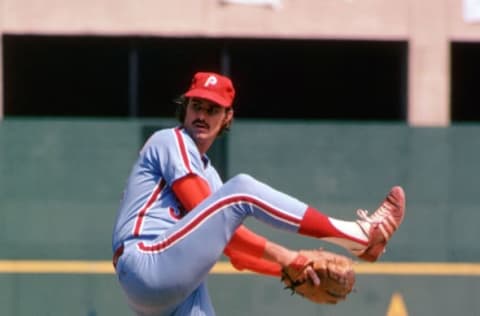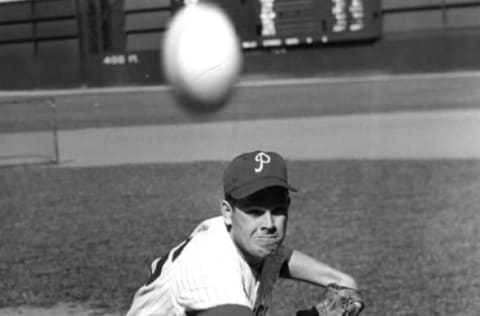Every number retired by the Philadelphia Phillies

Which numbers are retired by the Philadelphia Phillies?
The Philadelphia Phillies are one of the oldest franchises in Major League Baseball, but now in their 140th season, they’re one of the stingiest when it comes to retiring numbers.
Including Jackie Robinson’s 42, which is retired leaguewide, the Phillies have only bestowed the honor of a retired number upon 10 former players. Here’s who you can find at Citizens Bank Park’s Ashburn Alley:
Grover Cleveland Alexander – P
Chuck Klein – P
Richie Ashburn – 1
Jim Bunning – 14
Dick Allen – 15
Mike Schmidt – 20
Steve Carlton – 32
Roy Halladay – 34
Robin Roberts – 36
Jackie Robinson – 42
Grover Cleveland Alexander
Grover Cleveland “Pete” Alexander never wore a number and Chuck Klein wore seven (including 1, which would later be worn by Richie Ashburn), so instead of a retired number, each has a ‘P’ on the wall at Ashburn Alley.
A three-time Triple Crown pitcher (win-loss, ERA, strikeout) and five-time ERA titleholder, Alexander was a member of the Hall of Fame’s inaugural class in 1939. The best seasons of his 20-year career were the first seven, which he spent with the Phillies. He then became their first huge trade mistake, as he continued to be dominant for the Chicago Cubs and St. Louis Cardinals, winning a World Series with the latter in 1926. In 1930, he returned to the Phillies for nine games before retiring.
Over a century later, Alexander is still one of the top-ranked pitchers in franchise history. He’s now third in WAR, wins, and innings pitched among Phillies pitchers, as Robin Roberts and Steve Carlton surpassed him. He threw 219 complete games, only to be surpassed by Roberts, who pitched 272, but Alexander’s .676 win percentage, 61 shutouts, and 2.38 FIP still reign supreme.
Chuck Klein
Chuck Klein was the first player in franchise history to win Most Valuable Player, back in 1932, and the only Phillies hitter to ever win the batting Triple Crown (AVG, HR, RBI), which he did in 1933, by hitting .368 with 28 home runs and 120 RBI.
Klein ranks ninth in position players WAR and Offensive WAR, and his slugging percentage and OPS have only been outdone by none other than Bryce Harper.
According to MLB.com, Klein’s 170 RBI and 445 total bases in 1930 are still records to this day for all National League lefty hitters.

Richie Ashburn, No. 1
Richie Ashburn, for whom the Alley is named, was not only one of the franchise’s best players, but after his playing days, one of their most popular broadcasters.
Ashburn spent the first 12 years of his 15-season career with the Phillies, including four All-Star seasons and two batting titles. Over 1,794 games in a Phillies uniform, Ashburn hit .311/.394/.388 with a .782 OPS. His 2,217 hits included 287 doubles and 97 triples, but only 22 home runs.
Among all Phillies hitters, Ashburn ranks third all-time in offensive WAR and fourth in position player WAR. Only Jimmy Rollins and Mike Schmidt played more games and collected more hits.
Jim Bunning, No. 14
A nine-time All-Star and Hall of Famer, Jim Bunning is perhaps one of the most underrated pitchers in MLB history.
Only six of his 17 MLB seasons were with the Phillies, but they included his best. He threw a perfect game on Father’s Day in 1964, and in 1966 and 67, he led MLB in starts with a combined 81 games and 616 1/3 innings, throwing over 300 innings in each year. In 1967, despite outdoing Giants pitcher Mike McCormick in WAR, ERA, games started, and throwing 40 more innings, Bunning finished runner-up for NL Cy Young. Essentially, he was the original 2021 Zack Wheeler.
On this date in 1964, the late Jim Bunning tossed the seventh perfect game in MLB history in a 6-0 victory over the Mets. pic.twitter.com/cP5WNiRNHg
— Philadelphia Phillies (@Phillies) June 21, 2017

Dick Allen, No. 15
What sets Dick Allen apart from everyone else on this list is that he’s not in the Baseball Hall of Fame. It’s a long overdue and egregious error that needs to be rectified.
In fact, Allen’s number was retired in 2020 because Phillies owner John Middleton felt that the franchise should honor Allen, since the Hall was not.
In 1964, the young Phillie won NL Rookie of the Year, leading MLB in runs scored and triples. He was an All-Star the next three seasons. Allen’s 43.1 offensive WAR still ranks seventh among Phillies players, and his .530 slugging percentage and 153 OPS+ are fourth.
Mike Schmidt, No. 20
Unsurprisingly, the greatest third baseman in baseball history made the cut.
He’s the Phillies’ all-time leader in position player WAR, offensive WAR, and defensive WAR, games played, runs scored, total bases, home runs, RBI, walks, and a host of other offensive metrics.
Over his magnificent 18-year career, Schmidt was a 12-time All-Star, 10-time Gold Glove third baseman, six-time Silver Slugger, three-time MVP, and led the Phillies to their first World Series championship in 1980. He’s a member of the 500 HR club, and was the 26th candidate in MLB history to be elected to the Baseball Hall of Fame in his first year on the ballot.

Steve Carlton, No. 32
As the first pitcher in MLB history to win four Cy Young Awards, Steve Carlton pitched his way onto the wall like no one before him.
In a pleasant turn of events, Carlton was acquired in a rare successful trade for the Phillies, who got him from the St. Louis Cardinals ahead of the 1972 season. Over 15 seasons with the Phillies, Carlton posted a 3.09 ERA over 499 starts, including 185 complete games.
Carlton and Mike Schmidt led the Phillies to five division titles, and two pennants, including their first-ever championship season in 1980, and back to the World Series in 1983.
Roy Halladay, No. 34
The late, great Roy Halladay wasn’t in Philly very long, but he made the most of his four seasons with the club, winning the 2010 Cy Young award and leading MLB with 21 wins in his first season, adding two All-Star Games to his resumé, and helping the Phillies to their fourth and fifth consecutive division titles in 2010 and 2011. They haven’t won the division since.
On May 29, 2010, Halladay threw the second perfect game in franchise history (Jim Bunning’s was the first). That fall, in the NLDS, he became just the second pitcher in MLB history to throw a no-hitter in the postseason.

Robin Roberts, No. 36
Robin Roberts spent 14 years in the Phillies uniform between his rookie season in 1948 and 1961. During that span, he led MLB in wins (4 consecutive seasons), starts (6 consecutive), and complete games and innings pitched (5 consecutive each).
The Cy Young Award didn’t exist until 1957, but Roberts had an abundance of Cy Young-worthy seasons before that. Instead, he won Pitcher of the Year three times.
Roberts is the Phillies’ all-time leader in pitcher WAR, games played, innings pitched, and complete games. Steve Carlton surpassed him in starts, strikeouts, and wins, but before he arrived on the scene, Roberts had the Phillies leaderboards on lock.
Perhaps his most shocking stat? Between 1952-53, Roberts threw 28 complete games consecutively.
Jackie Robinson, No. 42 (Retired leaguewide)
In 1947, Jackie Robinson ended segregation in Major League Baseball by becoming its first Black player. His number has been retired leaguewide since 1997, and each year on April 15, every player wears 42 on their back in his honor.